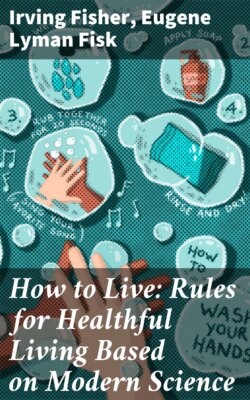Читать книгу How to Live: Rules for Healthful Living Based on Modern Science - Irving Fisher - Страница 33
На сайте Литреса книга снята с продажи.
Section II—Protein Foods
ОглавлениеTable of Contents
Protein, Fat, and Carbohydrate
In the last section it was stated that food is fuel. But there is one constituent of food which, while it can be used as fuel, is especially fitted for an entirely different purpose, namely, to build tissue, that is, to serve for the growth and repair of the body. This tissue-building constituent in food is called protein. The two other chief constituents in food are fat and carbohydrate, the last term embracing what are familiarly known as starch and sugar. Fats and carbohydrates are only for fuel and contain carbon as the essential element. Protein contains nitrogen as the essential element in tissue-building. The white of egg and the lean of meat afford the most familiar examples of protein. They consist entirely of protein and water. But meat and eggs are not the only foods high in protein. In fact, most ordinary foods contain more or less protein. The chief exceptions are butter, oleomargarine, oil, lard, and cream—which consist of fat (and water)—and sugar, sirups, and starch, which consist of carbohydrate (and water).
Proportion of Protein
Foods should be so selected as to give to the ration the right amount of protein, or repair-foods, on the one hand, and of fats and carbohydrates, or fuel-foods, on the other. A certain amount of protein is absolutely essential. While, for a few days, protein may be reduced to little or nothing without harm, if the body be long deprived of the needed protein it will waste away and ultimately death will result. Therefore, too little protein would be a worse mistake than too much.
The right proportion of protein has been the subject of much controversy. According to what are regarded as the best investigations, it is generally about 10 per cent. of the total number of heat-units consumed. This does not, of course, mean 10 per cent. of the total weight nor 10 per cent. of the total bulk, but 10 per cent. of the total nutriment, that is, 10 calories of protein out of every 100 calories of food.
Human Milk
Most persons in America eat much more protein than this. But that 10 calories out of 100 is not too small an allowance is evidenced by the analysis of human milk. The growing infant needs the maximum proportion of protein. In the dietary of the domestic animals, the infant’s food, the mother’s milk, is richer in protein than the food of the grown animal. Consequently an analysis of human mother’s milk affords a clue to the maximum protein suitable for human beings. Of this milk 7 calories out of every 100 calories are protein. If all protein were as thoroughly utilized as milk-protein or meat-protein, 7 calories out of 100 would be ample, but all vegetable proteins are not so completely available. Making proper allowance for this fact, we reach the conclusion that 10 calories out of every 100 are sufficient.
Excessive Use of High-Protein Foods
A chief and common error of diet consists, then, in using too much protein. Instead of 10 calories out of every 100, many people in America use something like 20 to 30. That is, they use more than double what is known to be ample. This excessive proportion of protein is usually due to the extensive use of meat and eggs, although precisely the same dietetic error is sometimes committed by the excessive use of other high-protein foods such as fish, shell-fish, fowl, cheese, peas and beans, or even, in exceptional cases, by the use of foods less high in protein when combined with the absence of any foods very low in protein. The idea of reducing the protein in our diet is still new to most people.
Injuries From Over-abundance of Protein
Prof. Rubner of Berlin, one of the world’s foremost students of hygiene, said, in a paper on “The Nutrition of the People,” read before the recent International Congress on Hygiene and Demography:
“It is a fact that the diet of the well-to-do is not in itself physiologically justified; it is not even healthful. For, on account of false notions of the strengthening effect of meat, too much meat is used by young and old, and by children, and this is harmful. But this meat is publicly sanctioned; it is found in all hotels; it has become international and has supplanted, almost everywhere, the characteristic local culinary art. It has also been adopted in countries where the European culinary art was unknown. Long ago the medical profession started an opposition to the exaggerated meat diet, long before the vegetarian propaganda was started. It was maintained that flour foods, vegetables, and fruits should be eaten in place of the overlarge quantities of meat.”
When protein is taken in great excess of the body’s needs, as is usually the case in the diet of Americans, added work is given the liver and kidneys, and their “factor of safety” may be exceeded.
